Top Previous Year Questions - Mechanical Properties of Fluids
Question
A fluid is flowing through a horizontal pipe of varying cross-section, with at a point where the pressure is Pascal. At another point where pressure Pascal its speed is . If the density of the fluid is and the flow is streamline, then is equal to
JEE Main 2020 (06 Sep Shift 2)
Options
- A:
- B:
- C:
- D:
Explaination
Question
A small spherical droplet of density is floating exactly half immersed in a liquid of density and surface tension The radius of the droplet is (take note that the surface tension applies an upward force on the droplet):
JEE Main 2020 (09 Jan Shift 2)
Options
- A:
- B:
- C:
- D:
Explaination
Question
When a long glass capillary tube of radius is dipped in a liquid, the liquid rises to a height of within it. If the contact angle between the liquid and glass to close to , the surface tension of the liquid, in milliNewton is (Given answer in closed integer)
JEE Main 2020 (03 Sep Shift 1)
Enter your answer
Explaination
Question
A capillary tube made of glass of radius is dipped vertically in a beaker filled with methylene iodide (surface tension , density ) which rises to height in the tube. It is observed that the two tangents drawn from observed that the two tangents drawn from liquid-glass interfaces (from opp. sides of the capillary) make an angle of with one another. Then is close to ()
JEE Main 2020 (02 Sep Shift 2)
Options
- A:
- B:
- C:
- D:
Explaination
Question
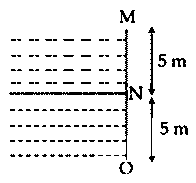
Two liquids of densities and are filled up behind a square wall of side as shown in figure. Each liquid has a height of The ratio of the forces due to these liquids exerted on upper part MN to that at the lower part NO is (Assume that the liquids are not mixing):
JEE Main 2020 (08 Jan Shift 2)
Options
- A:
- B:
- C:
- D:
Explaination
Question
Two small drops of mercury each of radius coalesce to form a single large drop. The ratio of total surface energy before and after the change is
JEE Main 2021 (20 Jul Shift 2)
Options
- A:
- B:
- C:
- D:
Explaination
Question
Two narrow bores of diameter and are joined together to form a shaped tube open at both ends. If this tube contains water, what is the difference in the level of two limbs of the tube.
[Take surface tension of water , angle of contact and density of water
JEE Main 2021 (26 Aug Shift 1)
Options
- A:
- B:
- C:
- D:
Explaination
Question
A light cylindrical vessel is kept on a horizontal surface. Area of the base is A hole of cross-sectional area is made just at its bottom side. The minimum coefficient of friction necessary to prevent sliding the vessel due to the impact force of the emerging liquid is
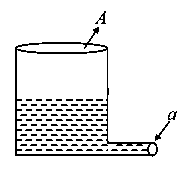
JEE Main 2021 (27 Jul Shift 1)
Options
- A:
- B: None of these
- C:
- D:
Explaination
Question
A hydraulic press can lift when a mass is placed on the smaller piston. It can lift kg when the diameter of the larger piston is increased by times and that of the smaller piston is decreased by times keeping the same mass on the smaller piston.
JEE Main 2021 (24 Feb Shift 1)
Enter your answer
Explaination
Question
Consider a water tank as shown in the figure. It's cross-sectional area is . The tank has an opening near the bottom whose cross-section area is . A load of is applied on the water at the top when the height of the water level is above the bottom, the velocity of water coming out the opening is . The value of , to the nearest integer, is ___ .[Take the value of to be ]
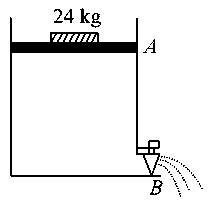
JEE Main 2021 (18 Mar Shift 2)
Enter your answer
Explaination
Question
A water drop of radius is broken into equal droplets. If surface tension of water is , then the gain in surface energy upto first decimal place will be
[Given ]
JEE Main 2022 (26 Jul Shift 1)
Options
- A:
- B:
- C:
- D:
Explaination
Question
The velocity of a small ball of mass and density , when dropped in a container filled with glycerine, becomes constant after some time. If the density of glycerine is , then the viscous force acting on the ball, will be
JEE Main 2022 (27 Jun Shift 1)
Options
- A:
- B:
- C:
- D:
Explaination
Question
A pressure-pump has a horizontal tube of cross-sectional area for the outflow of water at a speed of . The force exerted on the vertical wall just in front of the tube which stops water horizontally flowing out of the tube, is: [given : density of water ]
JEE Main 2022 (28 Jul Shift 2)
Options
- A:
- B:
- C:
- D:
Explaination
Question
Consider a cylindrical tank of radius is filled with water. The top surface of water is at from the bottom of the cylinder. There is a hole on the wall of cylinder at a height of from the bottom. A force of is applied an the top surface of water using a piston. The speed of efflux from the hole will be :
(given atmospheric pressure , density of water and gravitational acceleration )
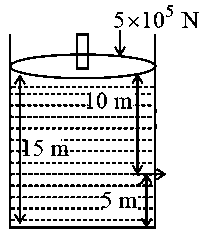
JEE Main 2022 (28 Jul Shift 2)
Options
- A:
- B:
- C:
- D:
Explaination
Question
An ideal fluid of density , flows smoothly through a bent pipe (as shown in figure) that tapers in cross-sectional area from a to . The pressure difference between the wide and narrow sections of pipe is . At wider section, the velocity of fluid is for _____ . (Given )

JEE Main 2022 (26 Jun Shift 1)
Enter your answer
Explaination
Question
A water drop of radius falls in a situation where the effect of buoyant force is negligible. Co-efficient of viscosity of air is and its density is negligible as compared to that of water . Terminal velocity of the water drop is
(Take acceleration due to gravity )
JEE Main 2022 (28 Jun Shift 2)
Options
- A:
- B:
- C:
- D:
Explaination
Question
A small ball of mass and density is dropped in a viscous liquid of density . After some time, the ball falls with a constant velocity. What is the viscous force on the ball?
JEE Main 2023 (06 Apr Shift 1)
Options
- A:
- B:
- C:
- D:
Explaination
Question
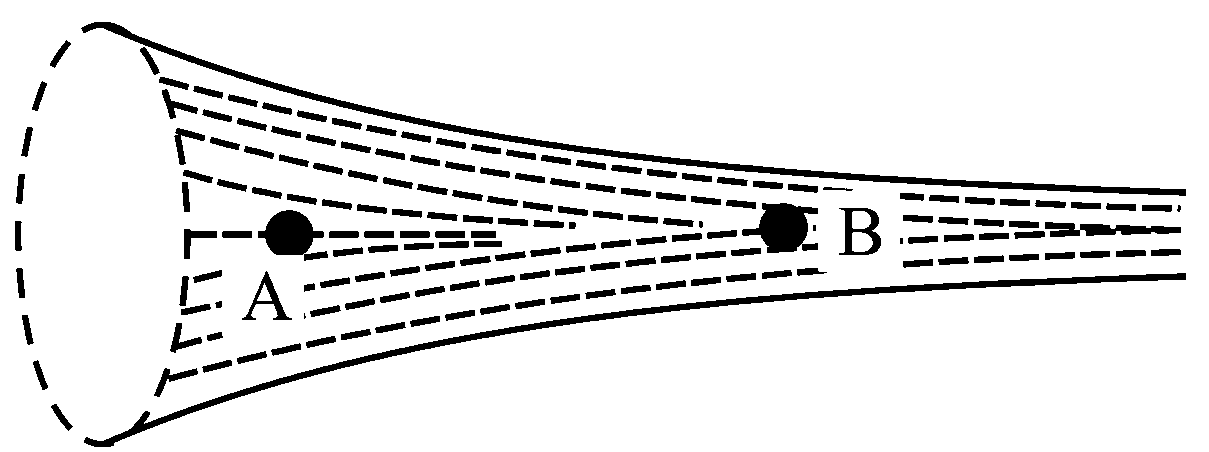
The figure shows a liquid of given density flowing steadily in horizontal tube of varying cross-section. Cross-sectional areas at is and is if the speed of liquid at is then is
(Given and are liquid pressures at and points.
Density
and are on the axis of tube)
JEE Main 2023 (13 Apr Shift 1)
Options
- A:
- B:
- C:
- D:
Explaination
Question
Given below are two statements: one is labelled as
Assertion A and the other is labelled as Reason R
Assertion A : A spherical body of radius having a particular density is falling through a liquid of constant density. The percentage error in the calculation of its terminal velocity is .
Reason R : The terminal velocity of the spherical body falling through the liquid is inversely proportional to its radius. In the light of the above statements, choose the correct answer from the options given below
JEE Main 2023 (13 Apr Shift 2)
Options
- A: Both A and R are true and R is the correct explanation of A
- B: Both A and R are true but R is NOT the correct explanation of A
- C: A is true but R is false
- D: A is false but R is true
Explaination
Question
Given below are two statements: one is labelled as Assertion A and the other is labelled as Reason R
Assertion A: When you squeeze one end of a tube to get toothpaste out from the other end, Pascal’s principle is observed.
Reason R: A change in the pressure applied to an enclosed incompressible fluid is transmitted undiminished to every portion of the fluid and to the walls of its container.
In the light of the above statements, choose the most appropriate answer from the options given below.
JEE Main 2023 (06 Apr Shift 2)
Options
- A: Both A and R are correct but R is NOT the correct explanation of A
- B: A is not correct but R is correct
- C: A is correct but R is not correct
- D: Both A and R is correct and R is the correct explanation of A
Explaination
Question
Given below are two statements : Statement I : When a capillary tube is dipped into a liquid, the liquid neither rises nor falls in the capillary. The contact angle may be $0^{\circ}$. Statement II : The contact angle between a solid and a liquid is a property of the material of the solid and liquid as well. In the light of the above statement, choose the correct answer from the options given below.
JEE Main 2024 (05 Apr Shift 1)
Options
- A: Both Statement I and Statement II are false
- B: Both Statement I and Statement II are true
- C: Statement I is false but Statement II is true
- D: Statement I is true and Statement II is false
Explaination
Question
Pressure inside a soap bubble is greater than the pressure outside by an amount : (given : $\mathrm{R}=$ Radius of bubble $\mathrm{S}=$ Surface tension of bubble)
JEE Main 2024 (06 Apr Shift 2)
Options
- A: $\frac{2 S}{R}$
- B: $\frac{4 R}{S}$
- C: $\frac{S}{R}$
- D: $\frac{4 \mathrm{~S}}{\mathrm{R}}$
Explaination
Question
A small liquid drop of radius is divided into identical liquid drops. If the surface tension is , then the work done in the process will be :
JEE Main 2024 (29 Jan Shift 2)
Options
- A:
- B:
- C:
- D:
Explaination
Question
Given below are two statements:
Statement I : If a capillary tube is immersed first in cold water and then in hot water, the height of capillary rise will be smaller in hot water.
Statement II : If a capillary tube is immersed first in cold water and then in hot water, the height of capillary rise will be smaller in cold water.
In the light of the above statements, choose the most appropriate from the options given below
JEE Main 2024 (29 Jan Shift 1)
Options
- A: Both Statement I and Statement II are true
- B: Both Statement I and Statement II are false
- C: Statement I is true but Statement II is false
- D: Statement I is false but Statement II is true